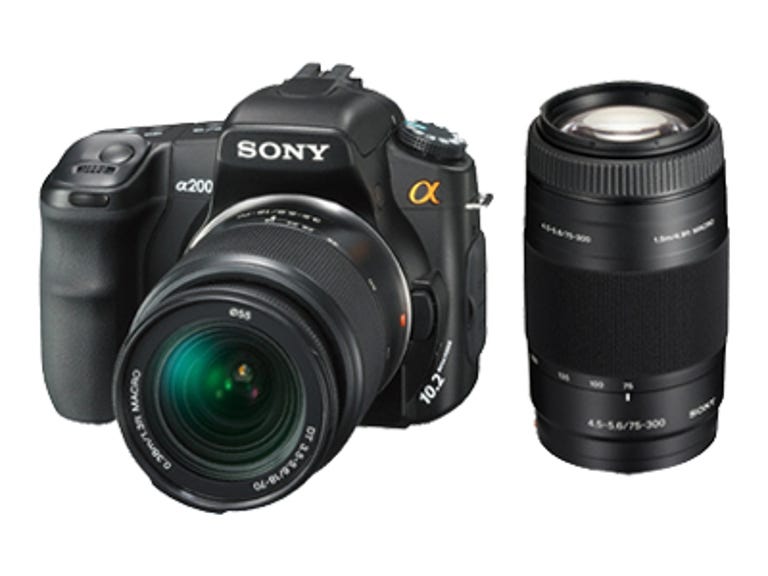 Why You Can Trust CNET
Why You Can Trust CNET Sony Alpha DSLR-A200 review: Sony Alpha DSLR-A200
Sony Alpha DSLR-A200
Sony's entry-level dSLR, the Alpha DSLR-A200, delivers a just-the-facts-ma'am shooting experience. For the most part, it provides the average design, basic feature set, modest performance, and better-than-snapshot photo quality that typifies this market segment: not bad, but not notable in any way, either.
The Good
The Bad
The Bottom Line
The 10.2-megapixel A200 comes in two kits: one with the SAL-1870 18-70mm f3.5-5.6 lens, which we tested, and a dual-lens kit that adds the SAL-75300 75-300mm f4.5-5.6 model. Those two lenses, plus the new SAL-55200, currently comprise Sony's complete entry-level lens lineup. For other inexpensive alternatives you'll have to turn to compatible A-mount Konica Minolta, Sigma, or Tamron offerings.
At 22.4 ounces with battery and CF card, the A200 weighs more than most of its competitors, despite its plastic-clad body. It feels solid, though, and the rubberized grip has a deep indent for your finger that makes the camera comfortable to hold. If you plan to connect the camera directly to your computer rather than use a card reader (which we don't recommend), then avoid the A200. For one, the USB connector is located inside the CF card compartment, which means you have to leave the door open while downloading, potentially allowing all sorts of schmutz to get onto the card-slot contacts (and, if you're as accident prone as me, providing a protrusion to hit and hurl the camera to the floor). More important, Sony uses a proprietary combo USB/AV connector on all its dSLRs, for no reason that I can see other than to force you to buy a cable from them if you lose the bundled one. That just peeves me.


Operating the A200 is straightforward. There are direct-access controls for ISO sensitivity, exposure compensation, and drive/bracketing/self-timer modes, while flash, AF, white balance, AF area, and D-RangeOptimizer settings are grouped under a screen pulled up by the Fn button.

The A200 supports wireless flash, uncommon but not unique in this price class, and I actually like the bare-bones implementation. Rather than grafting pro multichannel support on the camera, which can be quite confusing to configure, it's basically binary: on or off. The rest of its features--and their implementations--is pretty typical for its class, including sensor-shift image stabilization and a 2.7-inch LCD. (For a complete list of features, download the PDF manual.) Like most, but not all, of the cameras in this class, the A200 lacks Live View shooting, but you can get that by forking over another $100 for the otherwise identical DSLR-A300.
CNET Labs' tests indicate it wakes up and shoots very quickly--in roughly half a second. Under good, high-contrast lighting, it focuses and shoots in just under a third of a second, rising to a moderate 1.2 seconds in dimmer conditions. Typically, it captures consecutive frames in 0.6 second, jumping up to 1.3 seconds with the built-in flash enabled. Its 2.8 frames-per-second continuous shooting speed falls around the class average. Also as is typical for this segment, it has limited non-JPEG burst shooting capabilities: only 3 frames raw+JPEG or 6 frames raw in burst mode. In casual testing, the image-stabilization system delivered about 3 stops of latitude over what the reciprocal rule dictates--1/10 second versus 1/70 second for a 70mm focal length--which is pretty standard.
(Seconds--smaller is better)
| Time to first shot | Raw shot-to-shot time | Shutter lag (dim light) | Shutter lag (typical) |
(Frames per second--larger is better)
I do have a few performance gripes, though. For one, the 2.7-inch LCD is very difficult to view in direct sunlight. Second, the focus indicators for the 9 off-center focus points are lines (rather than squares), and very dim--some people may have trouble seeing them. And the shutter, or at least the mirror flip it drives, sounds unusually loud.
On the whole, the A200's photos looked okay, if unexceptional. It renders reasonable, if somewhat warm or cool automatic white balance, depending upon the lighting. In standard mode, exposures seem skewed too much toward the midtones--probably to avoid blown-out highlights--so images look a bit low contrast. Its noise profile looks good until ISO 800, at which point color artifacts become obvious, but that's par for the course on low-end SLRs. And the kit lens we tested produced soft photos.
This is the first entry-level camera we've seen in 2008, so it's quite possible that we'll be back to reevaluate the Sony Alpha DSLR-A200 more favorably in the context of its competition. But for now, there are better, more interesting models from earlier years whose prices are dropping into its territory; the Nikon D40x or Canon EOS Rebel XTi if you're willing to forgo the image stabilization, or the slightly more expensive Pentax K10D if you're not. You can even opt for the similar and still-available two-year-old Alpha DSLR-A100, if you don't shoot a lot at high ISO settings, and put the money you save toward a better lens.



